

William Stopford
Australia’s cheapest hybrid SUV just got cheaper
10 Hours Ago
The Kia Seltos GT-Line is a youth-focused, high-tech small SUV with punchy performance and a cool aesthetic. Downsides are few and far between, if you can afford it.



Senior Contributor

Senior Contributor


Senior Contributor

Senior Contributor
Quickly see how this car stacks up against its competition. Select any benchmark to see more details.
Where expert car reviews meet expert car buying – CarExpert gives you trusted advice, personalised service and real savings on your next new car.
In its short time on sale, the Kia Seltos has established itself as one of the better small SUVs out there.
Quite unlike a number of its ‘style-focused’ competitors, it actually offers plenty of interior space. And its cabin technologies are at the very head of the pack.
But is the flagship GT-Line variant the one to buy?
Kia’s list price for the GT-Line range-topper is $41,100 before on-road costs, with a factory-subsidised drive-away price of $42,990.
This is a not insignificant $5500 walk up from the Seltos Sport+ grade, which sits one rung beneath.
A quick check at the pricing of some key rivals adds more context. a Nissan Qashqai Ti is $38,490 before on-road costs, a Mitsubishi ASX Exceed is $33,240 before on-roads, and a Subaru XV 2.0i-S is $36,530 before on-roads.
Only the rival Mazda CX-30 G25 Astina ($43,490 before on-roads) really sits at the same price point as the Kia. Indeed, while this isn’t really a fair comparison based on fitted equipment, an entry Audi Q2 35 TFSI costs $41,950 before on-roads.
There’s nothing wrong with Kia charging a premium price-tag so long as the vehicle delivers the goods. Does it?
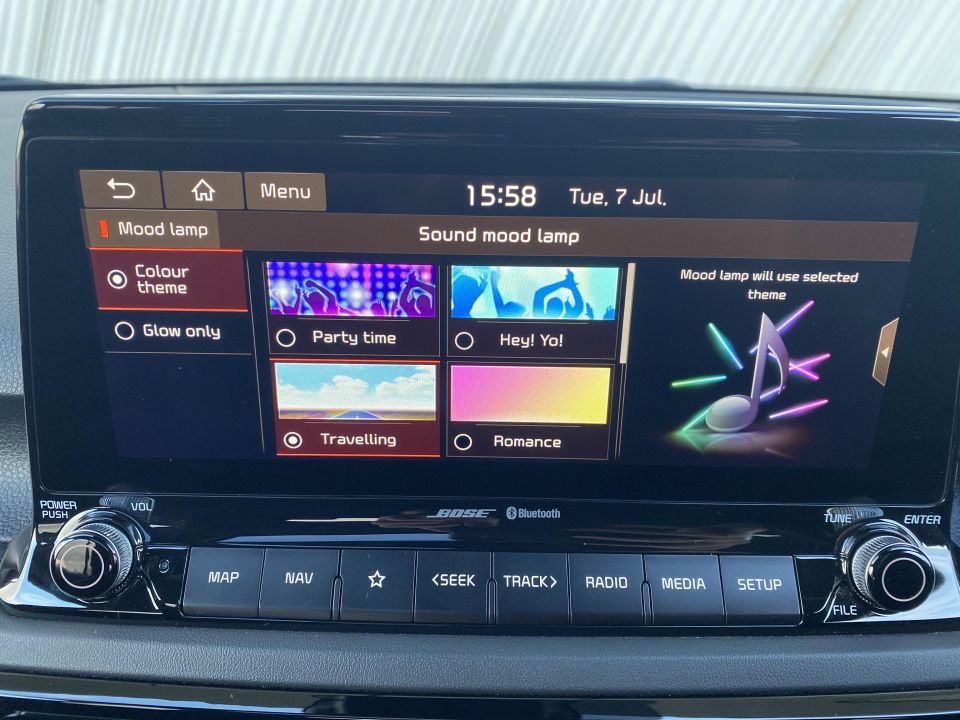
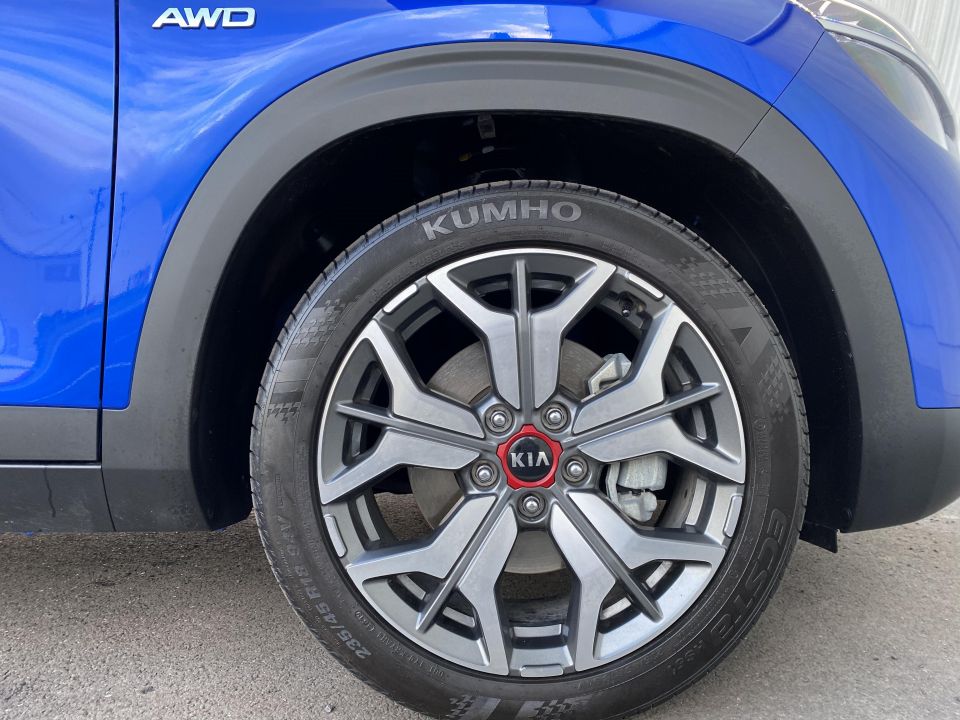

Buy your new car without the stress. It's fast, simple and completely free.

Great service from Travis and team, second time I have used this business would not hesitate to recommend them to anyone
Craig C.
Purchased a Ford Ranger in Sunshine Coast, QLD
CarExpert helped Craig save $7,224 on his Ford Ranger, now let us save you on your next new car.
Get your BEST priceWe’ll list the Sport+ turbo grade’s features, then explain what the GT-Line gets over and above this in return for the price premium.
So, the Sport+ has 17-inch alloy wheels with a full-size alloy spare, a proximity key fob, push-button start, parking sensors at each end, follow-me-home headlights, roof rails, electric-folding side mirrors, and rear privacy glass.
Inside it comes with LED reading lights, seats trimmed in cloth and imitation leather, two USB points, Bluetooth, AM/FM/DAB, six speakers, a 10.25-inch centre touchscreen, satellite-navigation with SUNA traffic updates, Android Auto and Apple CarPlay, a reversing camera, and digitised climate control.
The Kia Seltos GT-Line adds the following:
18-inch wheels on 20mm wider tyres, LED headlights (in place of yellow-hued halogens), LED daytime running lights, LED tail lights, LED fog lights, ‘premium’ heated and ventilated front seats with electric adjustment, a sunroof, rain-sensing wipers, a TFT trip computer, a head-up display, ambient cabin lighting in various colours that can ‘pulse’ along with music, a wireless phone charger, rear-seat air vents and USB point, and an eight-speaker Bose sound system.
So yes, it’s loaded with features. If the Sport+ had LED headlights I’d be inclined to recommend it, but if you can afford the price walk, the GT-Line shows the Seltos at its best.
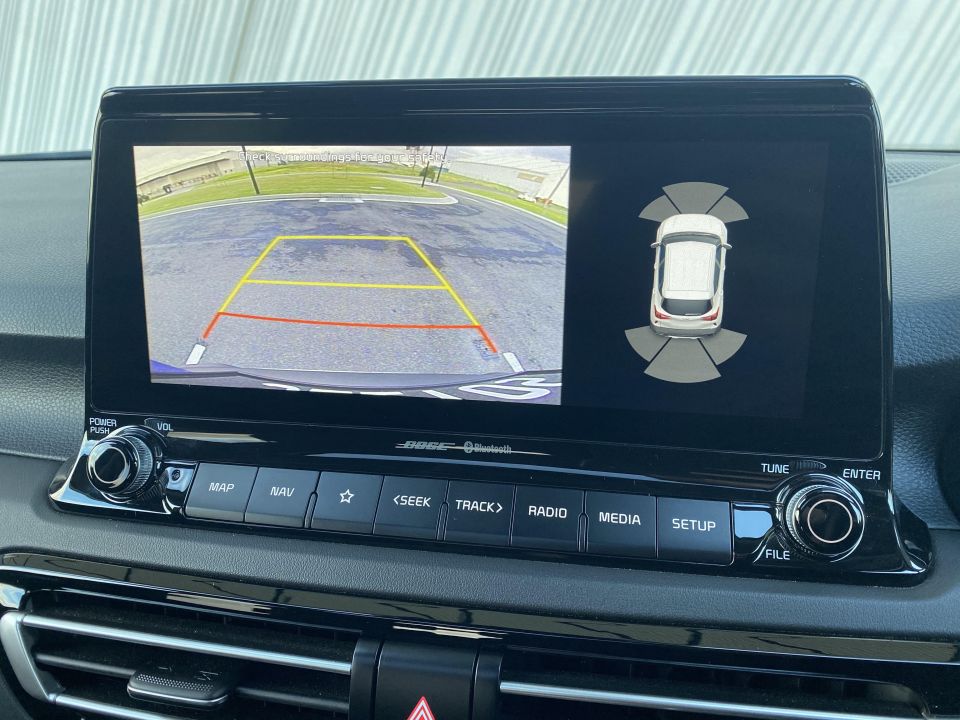
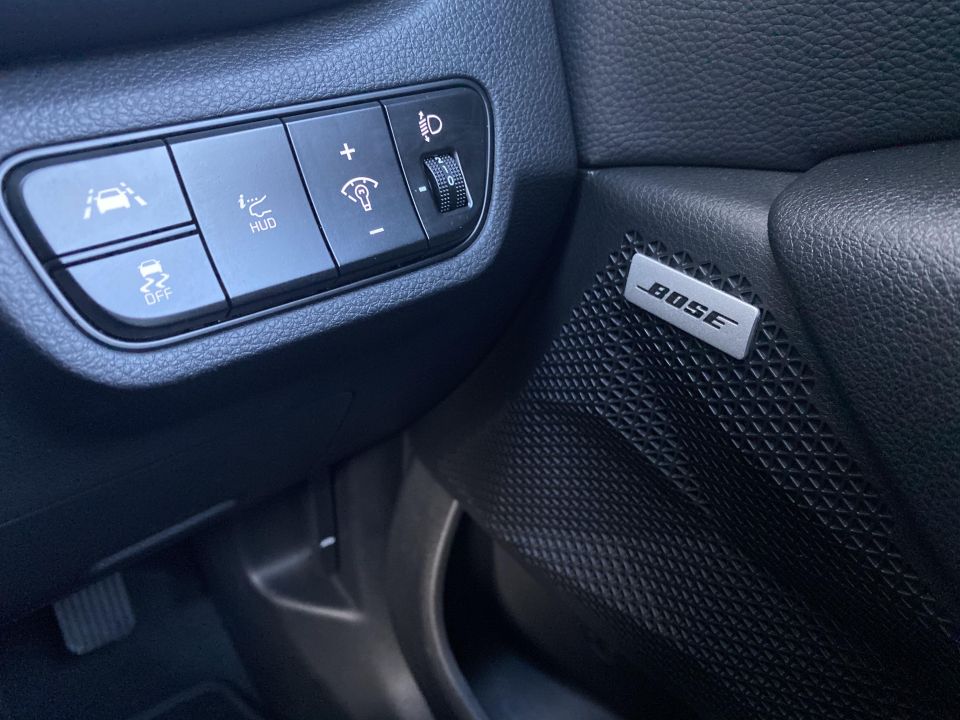
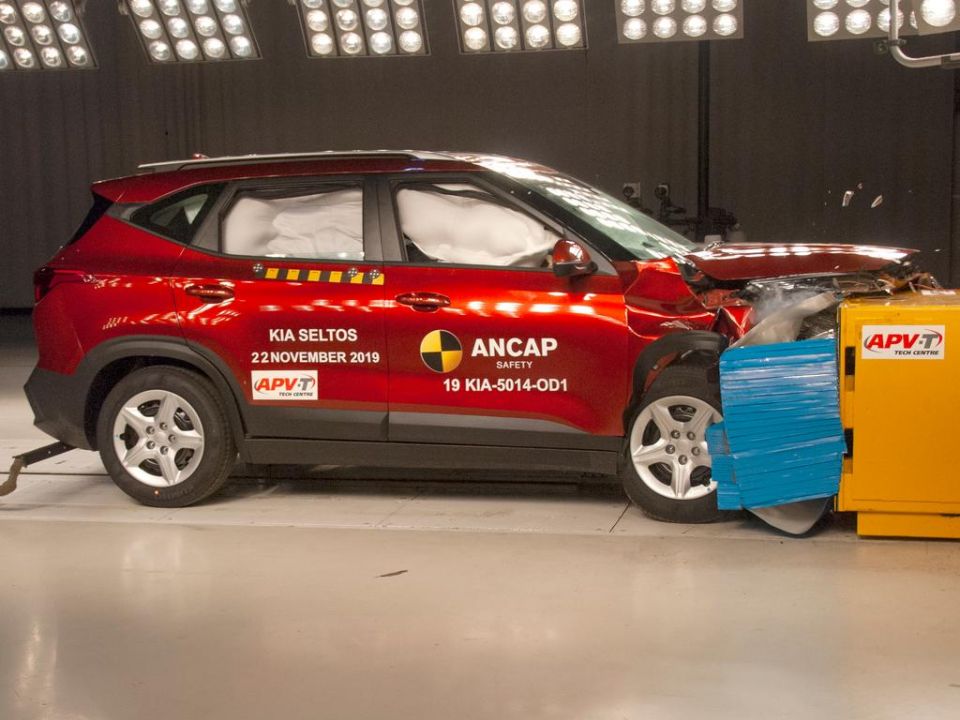
Safety features include six airbags, two ISOFIX child-seat anchor points and three top-tethers, autonomous emergency braking that can also detect pedestrians and cyclists, driver attention alert, blind-spot monitoring, lane-keeping assist, rear cross-traffic alert, and active cruise control.
Crash-tester ANCAP awarded the Seltos five stars in 2019, handing it 85 per cent for ‘adult occupant protection’ and 83 per cent for ‘child occupant protection’.
Cheaper grades of the Seltos managed ‘vulnerable road user protection’ and ‘safety assist’ category scores of 61 per cent and 70 per cent respectively. But the uprated camera and radar-based AEB system on the Sport Plus and GT-Line takes these scores to a better 68 per cent and 78 per cent respectively.
You can read the full safety report here.

The Kia Seltos is 175mm taller than a Kia Cerato hatch, and has an extra 42mm of ground clearance. This means more headroom and a higher driving position.
The leather-wrapped steering wheel has reach and rake adjustment, the seats slide and tilt electrically, and they’re both heated and ventilated. The flip-up head-up display’s height adjustment had a setting that worked for me, at 194cm. It’s good for watching your speed.
The design is typically austere, though two things liven up the vibe: the patterned Bose speaker covers are very cool, and the ambient light piping along the dash and in the footwells comes in a multitude of colours and pulses along to the beat when switched on.
The centre screen takes up a lot of real estate, has good processing speed, and an intuitive interface. The home screen has three tiles that show maps, audio, and trip data. But there’s a crisp camera view, and phone mirroring – albeit not of the wireless variety.
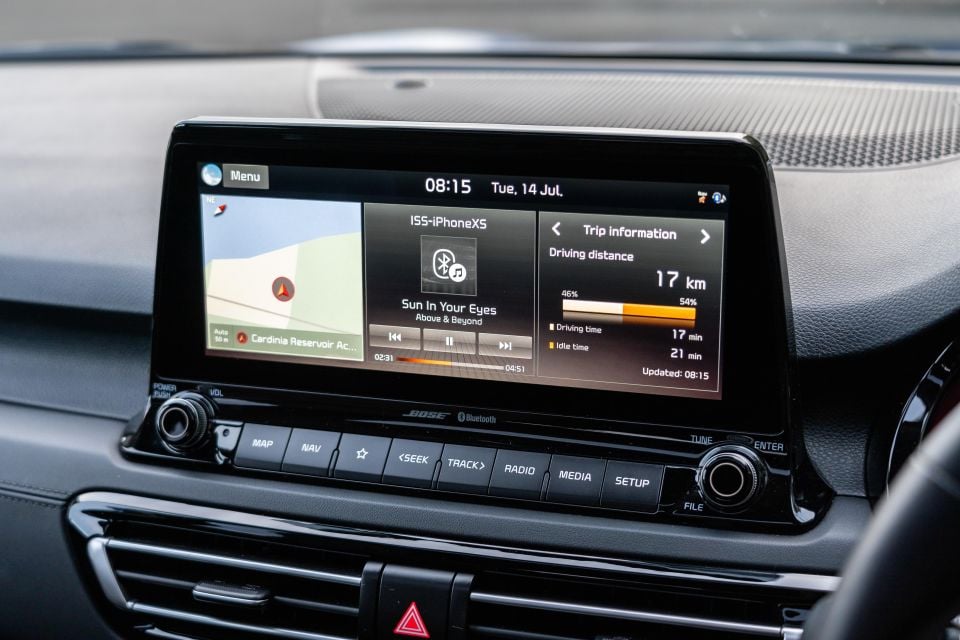
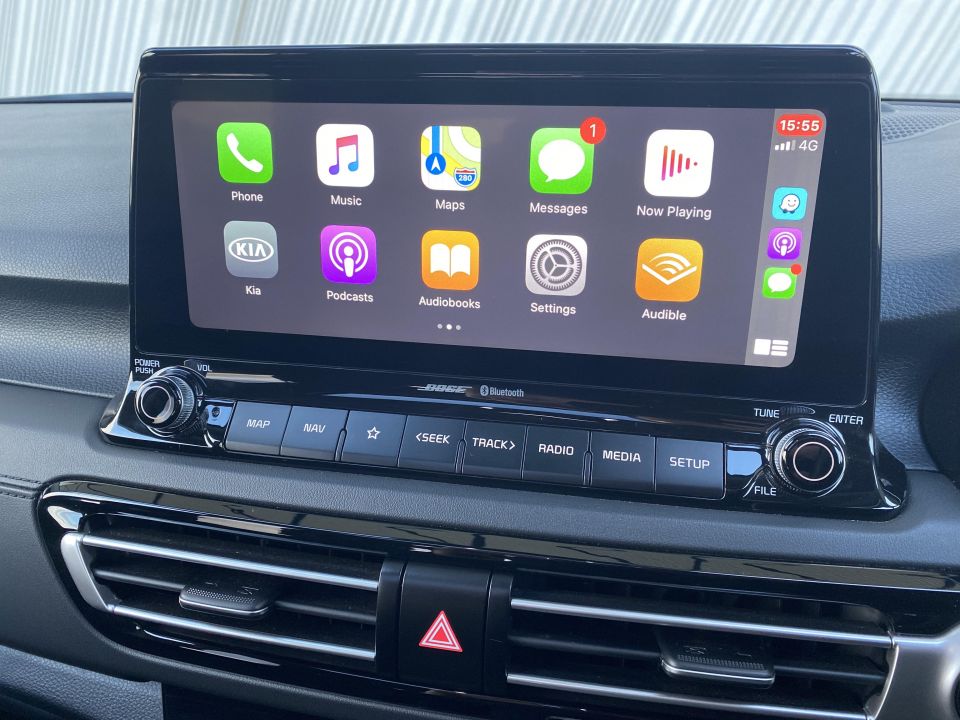
The fact Kia has retained a sequence of buttons and knobs to act as shortcuts is a good thing in my book. I also thought the audio quality was pretty good, without too much distortion or unpleasant vibrations during bass-heavy tunes.
Driving along in a small SUV with a HUD, pulsing ambient lighting in various colours, good audio quality blaring, the seat heater cranking, and the sunroof cover pulled back to let in the moon, is a pleasant experience for $43,000.
Storage options include four cup holders, door bottle holders, coat hooks, and decent centre console and glovebox areas.
Downsides? There aren’t a heap. You might say that the plastic trims used on the lower portions of the dash and along the transmission tunnel are hard to the touch and made to a price. Compared to the premium tactility of the Mazda CX-30, it’s quite clear.

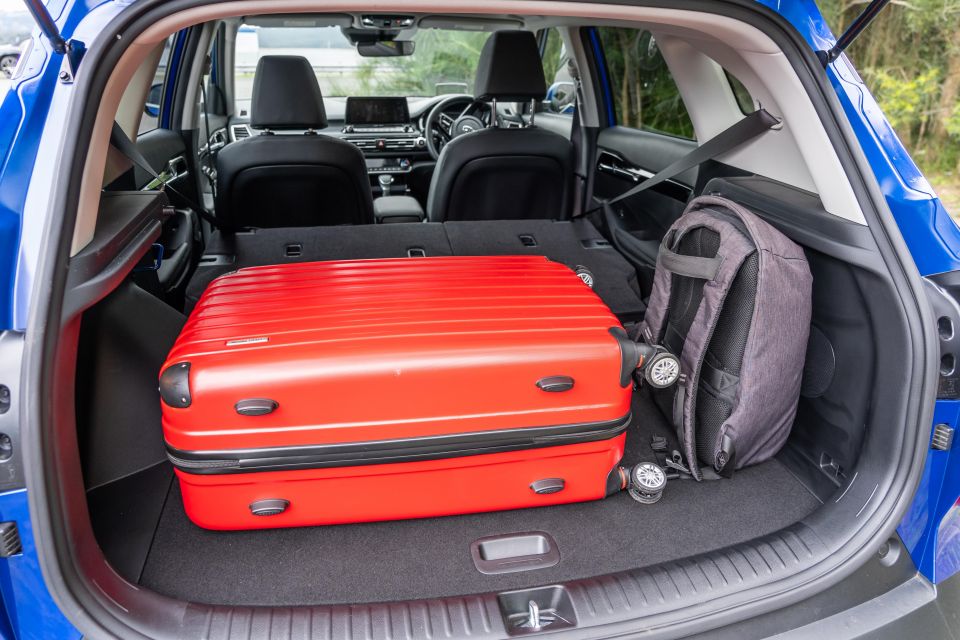
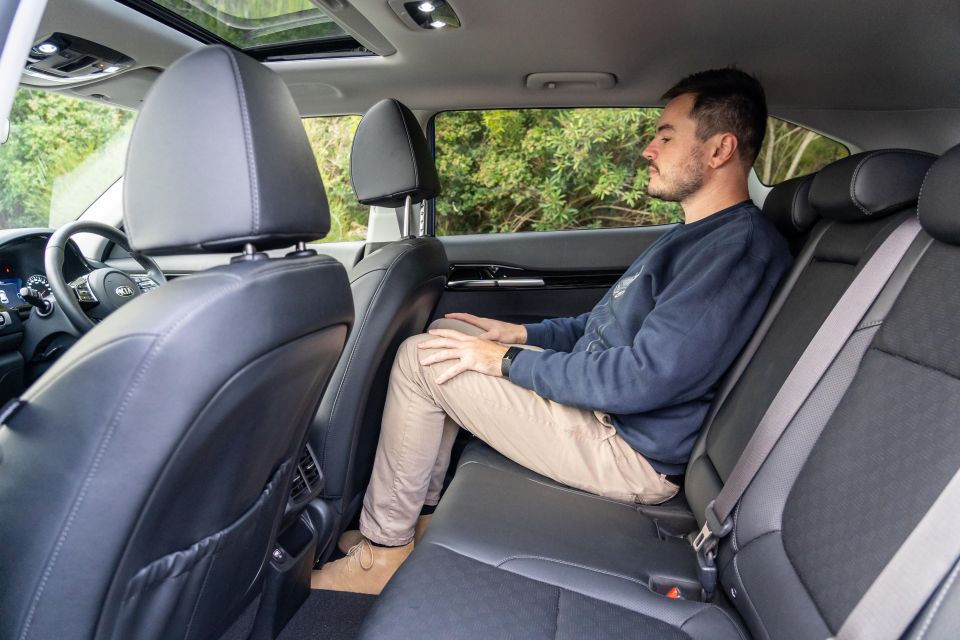
On the plus side, it’s bloody spacious for the segment, offering room more expected of SUVs in the next class up despite its fairly compact 4370mm length. As our 180cm-ish model Paul shows in the image above, there’s sufficient rear legroom and headroom for two adults.
Rear occupants get vents and USB access, LED reading lights, and seatback pockets. Parents will like the hard plastic front-seat-backs that feel ready to stand up to abuse from stroppy kids. The side windows are also larger and let in more light than a Toyota C-HR’s or CX-30’s do.
The boot space with five seats in use is 433 litres, which as the picture shows is enough for a large hard-shell case and backpack to sit comfortably side-by-side. The capacity is actually larger than any of the competitors mentioned, despite the full-sized alloy spare living under the floor.
The back seats fold pretty flat to up cargo space to 1393L. The only competitor that truly bests it for practicality is Honda’s HR-V. And even then it’s close.
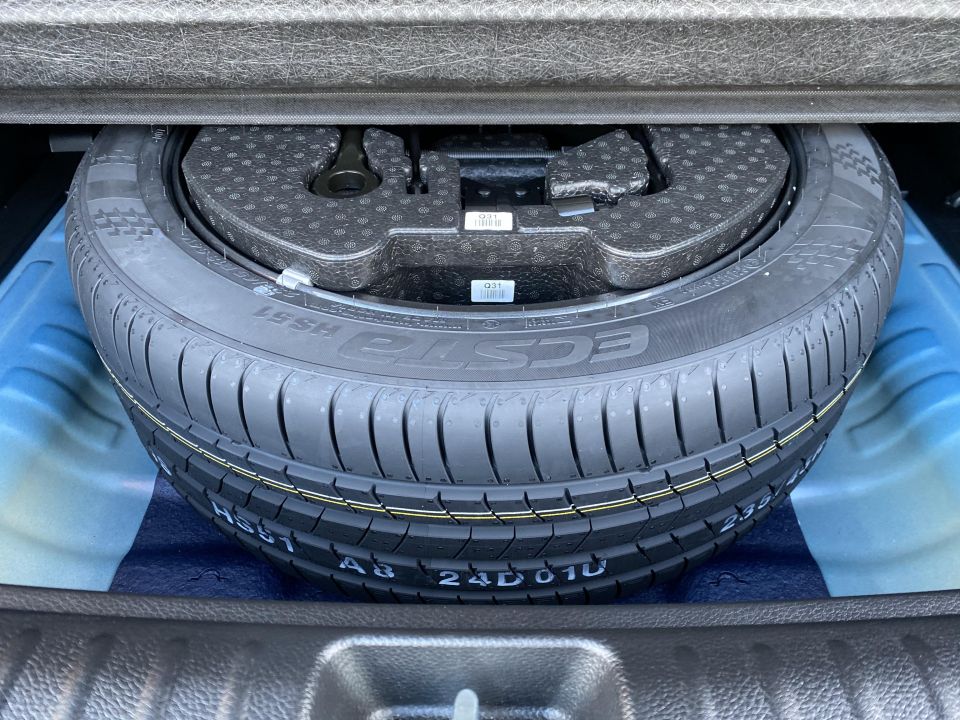

Many small SUVs are relatively gutless, front-wheel drive hatchbacks on stilts. While the Seltos comes in this configuration at entry level, the Kia Seltos GT-Line adds a little more performance. As it should.
The 1.6-litre turbocharged petrol engine makes 130kW of power at 6000rpm and 265Nm of torque between 1500 and 4500rpm. Those outputs are 20kW/85Nm higher than the naturally-aspirated base models, and sit right at the top of the segment.
You’ll reliably clock 0-100km/h times around the 8.0-second mark, which is almost hot-hatch like.
This engine comes with an on-demand all-wheel drive (AWD) system with a locking mode that fixes front-to-rear torque flow when you want it to, and a seven-speed dual-clutch automatic transmission.
Kia cites combined-cycle fuel consumption of 7.6 litres per 100km on the combined cycle (9.5L/100km urban and 6.3L/100km extra-rural). The engine can run on regular unleaded and is listed as E10 compatible. The tank is 50L.
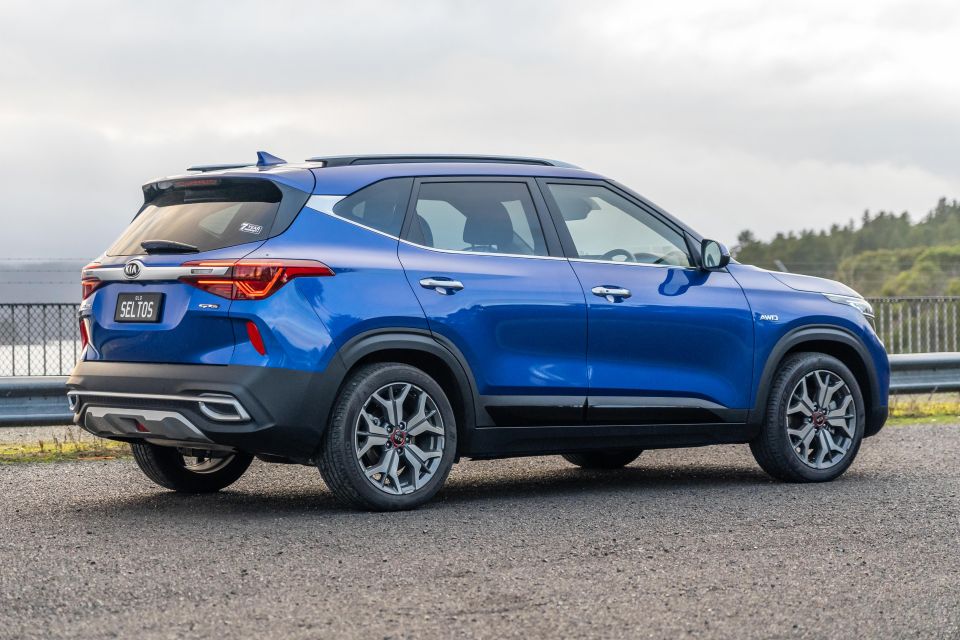

The engine doesn’t have a particularly entertaining exhaust note – the Cerato GT’s fake note seems absent – but the pickup is good and the wide torque band ensures you’ve always got reserves of oomph in hand.
The DCT is pretty smooth as far as these transmissions go, though the presence of a transmission fluid temperature gauge in the instruments suggests constant hill starts off-road might tax it.
It’s nice, frankly, to drive a small SUV that has sufficient power to actually make you smile.
The AWD system defaults to being front-wheel-biased, but on slippery surfaces it’s good to be able to reactively send engine torque to the rear. Numerous competitors including the ASX, Qashqai and HR-V do not have this option.
There are various driving modes to flick through, with the Sport setting telling the transmission to hold lower gears for a little longer and adding some weight to the already fairly resistant steering – something that not all target buyers will love, we’re sure.
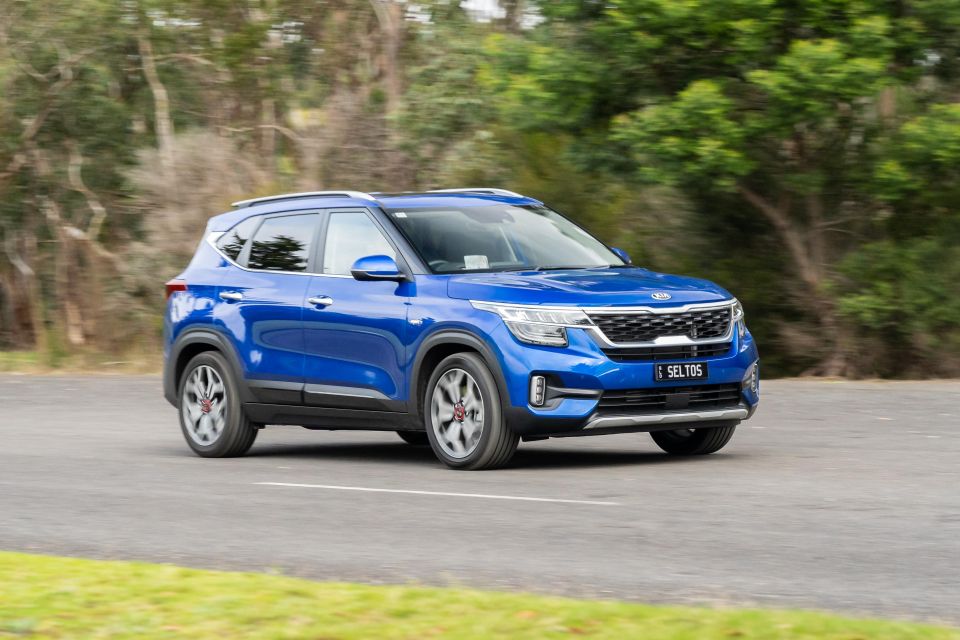
Unlike numerous competitors, turbo versions of Kia’s Seltos come with independent (multi-link) rear suspension to help with road holding, alongside McPherson struts up front, and passive dampers.
As per the norm, Kia’s Australian engineering team requested some changes to the factory settings based on local testing, and has settled on a firmish ride that keeps the body well controlled through corners. The Seltos is a tenacious handler, quite car-like.
Ride quality is generally fine, though those slimmer-sidewall tyres and larger wheels necessarily take the edge off sharp-bump absorption. While we’re lodging complaints, our test car’s body rigidity must be questioned since there was some mild but still-clear creaking from the sunroof over certain uneven surfaces, like a kerb.
Kia’s active safety systems work well, with the lane-keeping aid able to steer the car between road lines so long as they’re clearly marked. It also pairs up with the active cruise control to make it partially autonomous on highways, by staying centred in the lane.
Another function worth flagging is Safe Exit Alert which warns you of an approaching car running parallel if you’re stationary and preparing to open your door. For those who don’t do the ‘Dutch reach’ manoeuvre to check for cyclists, it could save a life.
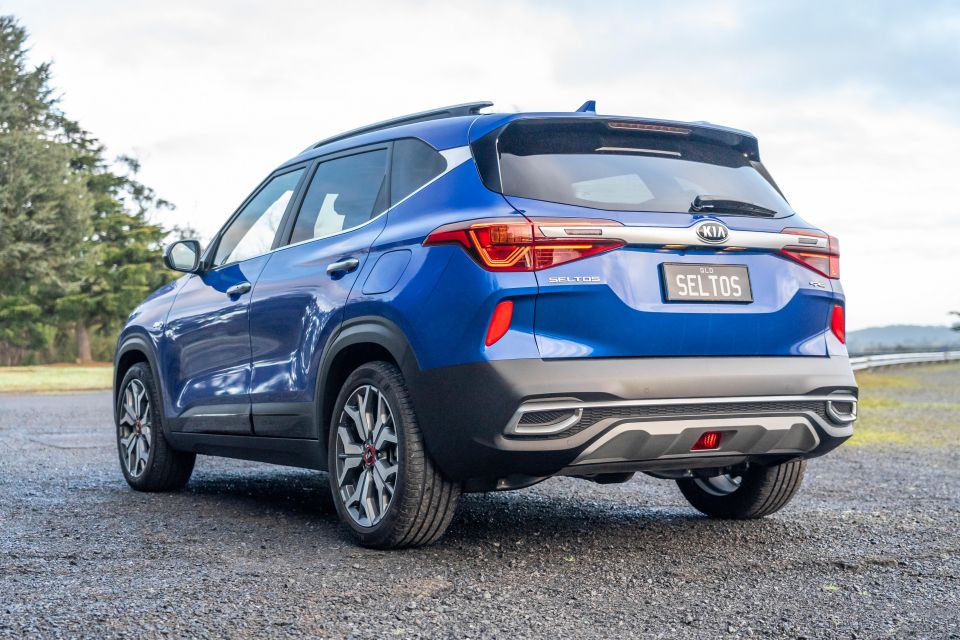
All Kias come with a seven-year warranty with no distance cap. Some other brands have followed in Kia’s wheel-tracks in offering such a lengthy term, but the Korean brand was first.
The company also provides a roadside assist plan for the warranty term so long as you return to any Kia dealer for servicing.
Kia publishes up-to-date service pricing on its website. At the time of writing the first seven visits cost: $282, $473, $346, $607, $317, $600 and $640.
Intervals are either annual or 10,000km (whichever comes first) – 5000km less than we’d prefer. Naturally-aspirated 2.0-litre Seltos models have 15,0000km intervals.
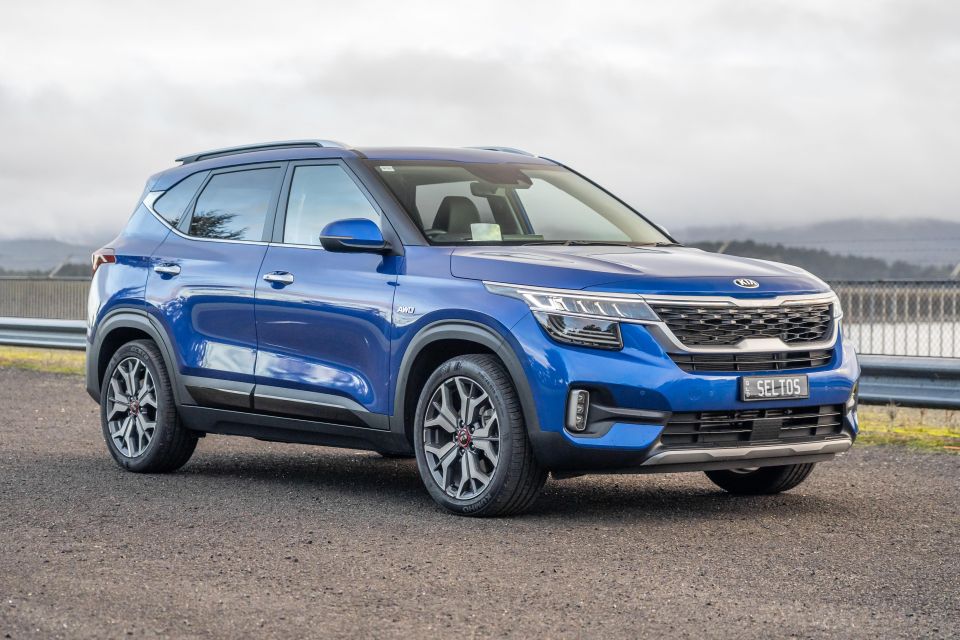
Buy your new car without the stress. It's fast, simple and completely free.

Great service from Travis and team, second time I have used this business would not hesitate to recommend them to anyone
Craig C.
Purchased a Ford Ranger in Sunshine Coast, QLD
CarExpert helped Craig save $7,224 on his Ford Ranger, now let us save you on your next new car.
Get your BEST priceThe Kia Seltos makes a very good case to be be considered the class leader, and it’s the GT-Line that offers the most compelling features and the coolest design within the range.
The price is getting up there, indeed knocking on the door of bigger and more premium SUVs, but the Kia offers more features than most of them and almost as much space.
In a segment full of some fairly uninspiring options, it ticks a lot of the right boxes.
Where expert car reviews meet expert car buying – CarExpert gives you trusted advice, personalised service and real savings on your next new car.


William Stopford
10 Hours Ago
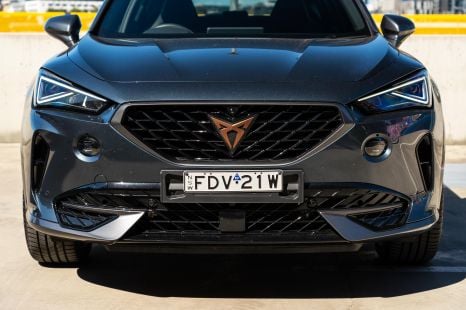

James Wong
12 Hours Ago


William Stopford
3 Days Ago


Matt Campbell
4 Days Ago


James Wong
6 Days Ago


Neil Briscoe
9 Days Ago